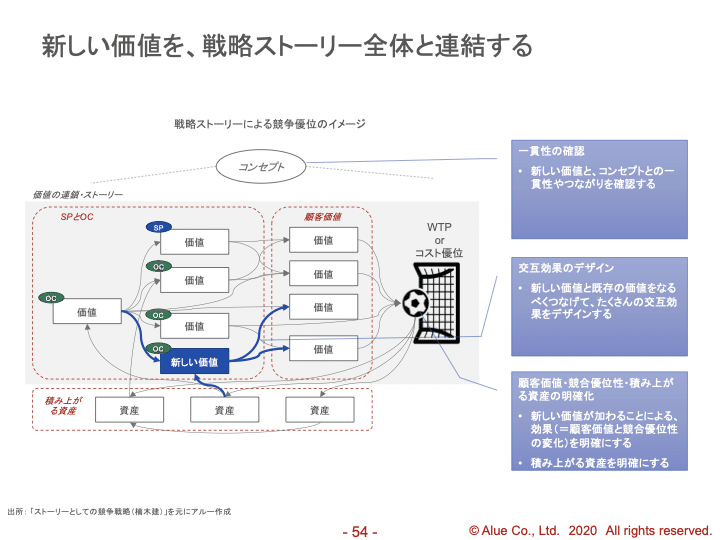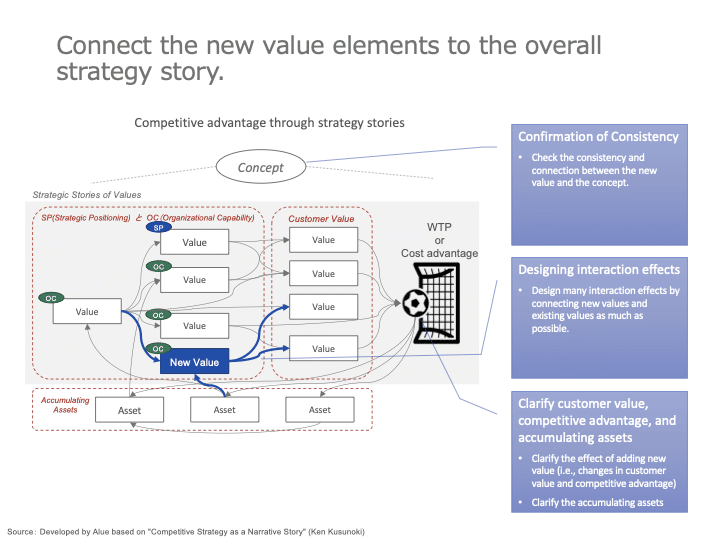
「面白い」発想を、顧客価値につなげるためにはどうすればよいのか?
前回の記事では、価値創造プロセスの三つ目となる「戦略ストーリー要素の導出」についてお話ししました。今回は、四つ目のプロセスとなる「連結化・ストーリー化」についてお話しします。
価値創造プロセスの全体像はこちらとなります。

新しい価値を、戦略ストーリー全体と連結する
④連結化・ストーリー化:
戦略ストーリー要素同士の価値の連鎖を連結し、発展ストーリーを描く
新しい価値が発想できたら、それまでの戦略ストーリー全体と連結させます。ここでは、コンセプトに対する一貫性の確認、交互効果のデザイン、顧客価値・競合優位の明確化を行います。

まずは、新しく発想した価値が、コンセプトにつながっているかどうかを改めて確認します。
それは、コンセプトを体現するものか?
「コンセプトにつながるような価値を考えているのだから、改めて確認するまでもないのでは?」

という疑問を持たれる方もいらっしゃるかもしれません。おっしゃる通り、コンセプトとのつながりが全くないということは殆どないと思います。それでも、新しく発想した価値そのもの、あるいは、その影響によって、コンセプトが弱まってしまったり、矛盾してしまったりすることはないかを確認することは大切と思います。
例えば、スターバックスでは2008年頃、それまでの成長に陰りが見えていました。その当時、売上拡大と効率化を重視するあまり、バリスタの教育が十分になされないままに店舗に配属されたり、サイドディッシュの品数を増やす中で、サイドディッシュの香りが店内のコーヒーの香りを毀損してしまう状況があったということを、ハワード・シュルツ氏が「スターバックス再生物語」の中で述べています。
このように、コンセプトにつながりながら取り組んでいるつもりであっても、売上や利益の最大化、株価の極大化など、コンセプトとは別のアジェンダが入り込んだときに、元々のコンセプトを弱めてしまったり、矛盾してしまったりすることがあります。
売上・利益・株価を高めていく取り組みが悪いという話ではありません。それも大切です。ただし、それによってコンセプトが弱まってしまうと、お客様やパートナーや社員など、身近なステークホルダーの心が離れていき、その結果として、中長期的な売上・利益・株価の成長を実現することはできなくなります。

コンセプトとのつながりを確認したら、次は、新しい価値と既存の価値をなるべくつなげて、たくさんの交互効果をデザインします。
価値単体を生み出すのは一合目に過ぎない
交互効果とは、要素となる価値同士のつながりの強さ、組み合わせの数の多さのことを指します。新しい価値を生み出すだけではなく、既存の価値とのつながりを強くしたり、たくさんの組み合わせをデザインして、具現化することが大切になります。
このプロセスの重要性は、いくら強調してもしすぎることはありません。新しい価値を生み出すということは、山登りで例えれば、まだ一合目にいる段階です。この新しい価値を既存の価値を繋げて、馴染ませることによって、顧客価値として実現するまで、長い道のりがあることが通常です。

「新しい価値を考えたら、既存の価値と組み合わせればいいだけでしょう?」
こんな疑問を持たれる方もいらっしゃるかもしれません。おっしゃる通り、概念的には組み合わせればいいだけなのですが、これを顧客が価値として実感するまで具現化していくには、いくつかクリアするべきハードルがあります。
一つ目のハードルは、顧客あるいは既存事業の社員の多くは、新しい価値をまだ知らないということです。社員は既存事業の仕事で忙しく、顧客はこれまでの商品・サービスを前提として、新しい価値があることなど知る由もない状況です。そのような状況の中で、新しい価値を社員や顧客に認知してもらい、そこに時間を割いてもらうということは簡単なことではありません。
二つ目のハードルは、ビジネスプロセスや業務フローが未整備であることです。既存の価値提供のためのビジネスプロセスは整っていますが、新しい価値を含めたビジネスプロセスや業務フローはまだ整っていない状況です。これが十分に整わない状況で、新しい価値を商品やサービスとしてローンチすると、フローが未整備であるが故に、一部の人の負荷が高まったり、トラブルやクレームが発生してしまうことにつながります。
このようなハードルをクリアしていくために、有効な手法となるのが、プロトタイピングによる具現化です。プロトタイピングとは、想定している価値の実現に向けて、完全なサービス・商品ではなく、(不完全な)試作品を創り、試行錯誤することで、価値の具現化(と既存価値との繋がりの実現)のスピードと確実性を高めることを指します。
プロトタイピングによって、新しい価値の具現化を試行錯誤するだけではなく、既存の価値との繋がりを検証したり、ビジネスプロセスや業務フローを作っていったり、関係する社員や顧客に、新しい価値を啓蒙していくことを一石三鳥・四鳥の発想でデザインします。

交互効果のデザインとプロトタイピングによる具現化を進めていくことができたら、最後のステップとして顧客価値・競合優位性・積み上がる資産の明確化を行います。
顧客価値や競合優位性は既に具現化しているという感覚
顧客価値とは、顧客がその会社やその商品を選ぶ理由として実感している価値のことを指します。スターバックスの例でいえば、コーヒーの美味しさや、店舗の居心地の良さが、顧客価値にあたります。一方で、スターバックスの価値の一つである「直営方式」というのは、顧客が実感する価値ではないので、顧客価値とは呼びません。
新しい価値が生み出されて、既存の価値との交互効果が実現した結果として、どんな新しい顧客価値が具現化したのか、あるいは、顧客価値にどのような変化があるのかを明確にします。
同様に、新しい価値が生み出されることによって、どのような競合優位性が生まれたのか、あるいは、変化したのかを明確にします。
大切なことは、顧客価値や競合優位性を、ここで考えて捻り出すというイメージではなく、すでに具現化しているものを言語化するというイメージであるということです。顧客価値や競合優位性は、これまでのプロセスによって自然と生み出されているのです。
顧客価値や競合優位性が自然と生み出されているというのはどういうことでしょうか?

これまで考えてきたことを思い返してみれば、顧客価値や競合優位性は、価値要素単体で生み出されるものというよりは、コンセプトと戦略ストーリーの全体によって実現されるものでしたね。
以前の記事で、コンセプトには「意識の偏在の解消」が含まれるという話をしました。新しい顧客価値は、意識の偏在の解消する価値として担保されます。スターバックスでいえば、第三の場所というコンセプトによって、第一の場所と第二の場所に囚われた生活に顧客価値が生み出されます。
競合優位性についても、「意識の偏在の解消」という要素から、ほぼ自動的に担保されます。競合のサービスや商品は、既存の意識構造において構想されたものが多いからです。その偏在を解消するという要素が含まれるコンセプトが具現化されれば、自然と競合との差別化ができている状態になります。スターバックスは、他のコーヒーショップとは違うということは皆さんも感じられているのではないでしょうか。

新しい価値が加わると、新たな資産が蓄積したり、資産の蓄積スピードが高まったりします。このような積み上がる資産を明確にしておくことも大切です。さらに次なる新しい価値を着想するときに、積み上がった資産があることで有利に働くからです。
ここまで、「連結化・ストーリー化」について、3つのポイント(一貫性の確認、交互効果のデザイン、顧客価値・競合優位・積み上がる資産の明確化)をお話ししてきました。次回は、この「連結化・ストーリー化」について、具体事例を用いながら咀嚼していきたいと思います。
本日の問いとなります。(よろしければ、コメントにご意見ください)
・あなたが携わった(提供した、または、購入した)サービス・商品において、コンセプトとは異なるアジェンダによって、コンセプトが弱まってしまった事例があるとすれば、それはどのような事例でしたか?
・あなたの経験において、新しい価値を着想するだけではなく、既存の価値と繋げて、馴染ませていくことが必要だった経験があるとすれば、それはどのような経験したか?
How can we turn "interesting" ideas into customer value?
In my previous article, I talked about the third process of value creation, "Derivation of Strategy Story Elements." In this article, I would like to talk about the fourth process, "consolidation and story making."
The whole value creation process is shown here.

Connect the new value elements to the overall strategy story
4) Consolidation and story making
Connect the chain of values between strategy story elements to create a development story.
Once the new value is conceived, it should be connected to the overall strategy story. Here, we confirm the consistency of the concept, design the effects of interaction, and clarify the customer value and competitive advantage.

First, reconfirm whether the newly conceived value is connected to the concept or not.
Does it embody the concept?
"Since we're thinking about the value that might lead to the concept, don't we need to go over it again?"
Some of you may ask this question. As you say, it is unlikely that there is no connection to the concept at all. Nevertheless, I think it is important to make sure that the concept is not weakened or contradicted by the newly conceived value itself or its effects.
For example, Starbucks experienced a slowdown in its growth around 2008. Howard Schultz, in his book "The Starbucks Rebirth Story," describes how the emphasis on sales growth and efficiency led to baristas being assigned to stores without adequate training, and the increase in the number of side dishes led to a situation where the smell of the side dishes spoiled the aroma of the coffee in the store.
In this way, even if we think we are working while connecting to the concept, we may weaken or contradict the original concept when agendas other than the concept enter the picture, such as maximizing sales and profits or maximizing stock price.
This is not to say that efforts to increase sales, profits, and stock prices are bad. It is important to do so. However, if our concept is weakened by such activities, we will lose the hearts and minds of our closest stakeholders, such as customers, partners, and employees, and as a result, we will not be able to achieve medium- to long-term growth in sales, profits, and stock price.
After confirming the connection with the concept, the next step is to design a lot of interaction effects, connecting the new value with the existing value as much as possible.
Creating value by itself is only the first step
The interaction effect refers to the strength of the connections between value elements and the number of combinations. It is important not only to create new values, but also to strengthen the connections with existing values, and to design and embody many combinations.
The importance of this process cannot be overemphasized. If we compare creating new value to climbing a mountain, we are still at the first stage. There is usually a long way to go before this new value is realized as customer value by connecting and blending it with existing values.
"Once we come up with a new value, why not just combine it with existing values?"
Some of you may have this kind of question. As you say, conceptually it is just a matter of combining the elements, but there are several hurdles to overcome in order to embody this value to the point where the customer realizes it.
The first hurdle is that many of the customers and employees of the existing business are still unaware of the new value. Employees are busy working on their existing businesses, and customers assume that the products and services are the same as before, and have no way of knowing that there is new value. In such a situation, it is not easy to get employees and customers to recognize the new value and to spend time on it.
The second hurdle is that business processes and workflows are not yet in place. The existing business processes for providing value are in place, but the business processes and workflows for including new value are not yet in place. If we launch a new value as a product or service in a situation where these are not sufficiently prepared, it will lead to an increase in the workload of some employees, problems and complaints because the workflow is not prepared.
In order to overcome these hurdles, an effective method is embodiment through prototyping. Prototyping refers to the process of creating (incomplete) samples of a service or product, rather than a complete service or product, in order to increase the speed and certainty of the realization of the value (and the realization of the connection with the existing values) through trial and error.
Prototyping is not only a trial and error process to realize new values, but also a way to verify the connection with existing values, create business processes and workflows, and enlighten relevant employees and customers about the new values, in a design that kills three or four birds with one stone.
Once the design and prototyping of the alternating effects is underway, the last step is to clarify the customer value, competitive advantage, and accumulating assets.
A sense that customer value and competitive advantage are already embodied
Customer value refers to the value that a customer perceives as the reason for choosing a company or its products. In the example of Starbucks, customer value includes the taste of the coffee and the comfort of the store. On the other hand, one of Starbucks' values, the "direct management system," is not a value that customers realize, so it is not called a customer value.
Clarify what new customer value has been embodied or what changes in customer value have occurred as a result of the creation of new value elements and the realization of interaction effects with existing value.
Similarly, identify what competitive advantage has been created or changed by the creation of the new value element.
The important thing is not to think of customer value or competitive advantage as something that we should come up with here, but rather as something that we can verbalize what we already have embodied. Customer value and competitive advantage are naturally created by the processes that have gone before.
What does it mean to say that customer value and competitive advantage are created naturally?
Thinking back on what we have been thinking, customer value and competitive advantage are not created by a single value element, but rather by the entire concept and strategic story.
In a previous article, I talked about how the concept involves the resolution of partiality of consciousness. The new customer value is secured as a value that eliminates the partiality of consciousness. In the case of Starbucks, the concept of the third place creates customer value in a life trapped in the first and second places.
Competitive advantage is also almost automatically ensured by the " resolution of partiality of consciousness" factor. This is because many of the services and products of competitors are conceived in the existing structure of consciousness. When a concept that includes the element to resolve partiality of consciousness is realized, the company will naturally be in a position to differentiate itself from the competition. I am sure that everyone has felt that Starbucks is different from other coffee shops.
As new value is added, new assets accumulate or the speed of asset accumulation increases. It is also important to have a clear idea of these accumulating assets, as they will work to our advantage when we come up with the next new value.
So far, I have discussed the three main points of "consolidation and story making" (confirming consistency, designing interaction effects, and clarifying customer value, competitive advantage, and accumulating assets). In the next article, I would like to elaborate on the theme of "consolidation and story making" using specific examples.
Here are the quests of the day. (If you'd like, please share your thoughts in the comments.)
・In what cases, if any, have you been involved in (provided or purchased) services or products where the concept was weakened by an agenda different from the concept?
・What experiences, if any, have you had that required you not only to conceive of new values, but also to connect and blend them with existing values?
Bunshiro Ochiai
この記事が気に入ったらサポートをしてみませんか?
